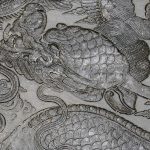Thousands Year of Silk
The craft of sericulture has existed for thousands of years in Vietnam, with mulberry fields and silkworms a part of everyday life since the early days of kingdom-building. Folk songs, proverbs and legends about silk live on as well, passed down from one generation to the next.

According to legend, Princess Thieu Hoa, the sixth Hung King’s (1712-1632 B.C.) daughter, is the founder of the sericulture craft. Due to her intelligence and keen observation, the princess mastered the secret of drawing filaments from silkworm cocoons and weaving them into silk. She chose not to live in the palace but moved to Co Do, a village nestled beside the Da River, to teach the people how to grow mulberries, raise silkworms and weave silk. Thanks to her, Co Do silk became a royal tribute and made its way into the timeless folk song: “Lụa này thật lụa Cổ Đô/ Chính tông lụa cống các cô ưa dùng” (“This silk is from Co Do village / The very silk was once a tribute to kings, beloved by ancient princesses.”)

The technique of raising silkworms was also summarized and recorded in the Chinese book Han Shu (Han History): “The Lac Viet people (who lived in the Red River delta region, in what is now northern Vietnam) are skilled in growing mulberries and raising silkworms. There are two rice planting seasons in one year and eight silkworm raising seasons.”

When Vietnam entered a period of independence and self-governance after a thousand years of Chinese domination, the domestic silk industry made significant strides. In 1040, under the reign of Ly Thai Tong, the Complete Annals of Dai Viet recorded silk’s growth: “The Emperor taught the palace women to weave gam and voc. That month, he issued a decree to distribute all the gam and voc from the Song Dynasty stored in the warehouse to make robes for the officials. Those of the fifth rank and above wore gam robes, and those of the ninth rank and above wore voc robes, to show that the Emperor no longer used gam and voc from the Song Dynasty.” The village of Nghi Tam on the edge of Dam Dam Lake (now West Lake, Hanoi) still bears traces of Princess Tu Hoa, daughter of Emperor Ly Than Tong, and the palace women who established the sericulture camp. She also encouraged the locals to engage in the craft, creating a famous region of the Thang Long Imperial Citadel for the sericulture industry.

By the 15th century, Nguyen Trai wrote in Du Dia Chi that there were nearly 20 villages, wards and households in Vietnam specializing in weaving high-quality products from fabrics related to silk such as gam, voc, truu, lua, linh, luot, la, the and sa. Some types of fabric were even finer than silk. A Yuan envoy, Tu Minh Thien, in Thien Nam Hanh Ky (a work in the Jiaozhou collection), praised Dai Viet for its fine multicolored silk threads, brocade woven with colors, and soft, shiny linh fabric.
With a traditional heritage, vast raw material regions and the skill and dedication of hardworking artisans, beautiful Vietnamese silk continues to carry the unique cultural characteristics of the people and their land.
The Maritime Silk Road
In the 17th century, the ancient town of Hoi An, located along the Thu Bon River and formerly part of the Nhat Nam district, was famous for the saying, “Men plant mulberry trees, women weave silk.” The story of the Silk Queen Tam Tang has captivated generations with the romantic tale of her love affair with Lord Nguyen Phuc Lan. When she became Empress, she encouraged the development of the sericulture industry. The local people combined knowledge from Dang Ngoai (North Vietnam in the 17th-18th century) with the mulberry cultivation and silkworm rearing experiences of the Champa people, along with the silk weaving secrets of the Minh Huong people, to create high-quality silk products. In the book Phu Bien Tap Luc (Miscellany on the Pacification at the Frontier), Le Quy Don praised the quality of silk from Quang Nam: “voc, sa, lanh, gam and truu with delicate floral patterns are very skillfully made”, he wrote. “The weavers of Thang Hoa and Dien Ban districts can weave various kinds of the, doan, lua, and la, featuring exquisite patterns, not inferior to those from Guangdong.” Under the Nguyen Lords, raw silk and various other types of silk from Quang Nam and Dang Trong were exported annually to Southeast Asian countries and the West through Hoi An. This port town became a transshipment center of the international maritime Silk Road.

With a history of a thousand years, traditional craft villages alone are not enough for Vietnam to secure a place on the modern global silk map. A significant transformation was necessary, and Bao Loc was the answer. Bao Loc, in Lam Dong Province, only emerged in the 1970s, but is now known as the “Silk Capital” of Vietnam. Thanks to favorable natural conditions such as climate and soil, and focused state planning, it has developed very strongly and now accounts for about 70% of the country’s total silk production value. Bao Loc silk has reached a level of refinement and unique value that has earned international trust.

Currently, Bao Loc has over 30 enterprises producing and trading silk. Its annual output reaches 1,200 tons of silk and 5 million meters of silk fabric. Bao Loc silk is consumed domestically and exported, significantly contributing to the socio-economic development of the region. In 2023 alone, the export value of raw silk in Lam Dong reached nearly USD72 million, the highest figure ever.





